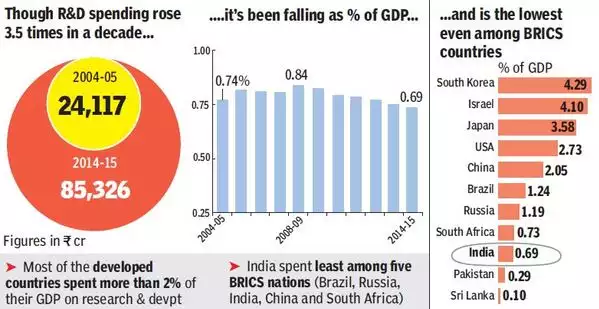MEAGRE FUNDS AND RED TAPE HOBBLE INDIAN SCIENCE
Relevance: GS 3 – Government Budgeting, Science and Technology- developments
Why in the News?
- Funding to crucial agencies like the Indian Council of Agricultural Research (ICAR), the Council of Scientific and Industrial Research (CSIR), the Department of Science and Technology, Department of Biotechnology, the Ministry of Earth Sciences and Indian Council of Medical Research and others has steadily decreased.
- This trend has been observed over the past few years.
Government Funding for Science in India:
- India’s direct funding for basic research has stagnated at 6-0.8% of GDP over the last decade.
- This is significantly lower compared to other BRICS nations.
- Total R&D expenditure has decreased from82% to 0.64% of GDP between 2005 and 2023.
Under Funding of the Research
- India’s under-funding of research is reflected in the low ratio of researchers to population.
- In 2017, there were only 255 researchers per million people in India.
- In comparison, countries like Israel, Sweden, and South Korea have significantly higher ratios of researchers per million people (8,342, 7,597, and 7,980 respectively).
Expansion of Universities and Institutes
- Over the past decade, the number of universities in India has increased from 752 to 1,016.
- Additional Indian Institutes of Technology and Indian Institutes of Science Education and Research have been established during this period.
- Discrepancy Between Institute Growth and Science Budget:
- Despite the rise in the number of institutes, there’s a lack of correlation with the science budget.
- Only seven out of 100 project proposals, on average, receive funding.
- Even approved projects face budget reductions by the finance bureaucracy.
Challenges in Funding Disbursement
- Delays in receiving funding are common, with even approved grants taking months to arrive.
- Researchers often receive sanctioned project funds towards the end of the financial year.
- Due to the ‘zero balance’ account norm introduced in April 2022, unspent funds are returned to the exchequer by March 31.
- Introduction of Quarterly Reporting Requirement:
- Principal investigators are now obligated to submit quarterly reports on ‘targets’, a new imposition.
- This requirement overlooks the nature of research, which involves trial and error rather than strict time management akin to engineering projects.
- The focus on chasing grants and writing reports detracts from researchers’ ability to contemplate complex problems.
Restrictions on Procurement of Equipment:
- Researchers’ freedom to procure equipment with specific specifications has been restricted.
- Purchases must be made through the government e-marketplace, compromising on equipment quality.
- Even for spare parts, tenders must be floated for domestic manufacturers first, regardless of quality.
- Delays in procurement, sometimes up to two months, can severely affect research progress, leading to demotivation and potentially costly failures.
Challenges in Fellowship Disbursement:
- Disbursal of fellowships for postdocs and PhD scholars has become difficult, with funds remaining elusive for months or even years.
- Delays in funding affect the ability to pay for manpower and supplies necessary for research.
- Previously, institutional backup funds were relied upon to overcome funding delays, but now research grants are kept with a bank.
- Funding hurdles demotivate students, leading to low turnover of PhD scholars.
Introduction of Anusandhan National Research Foundation (ANRF)
- The Union government approved the ANRF as a new funding mechanism, incorporating the Science and Engineering Research Board.
- The ANRF Act came into effect on February 5, with a DST secretary appointed as interim CEO.
- Its functioning will be overseen by an executive council chaired by the Principal Scientific Adviser to the government.
- The National Education Policy 2020 mentioned the National Research Foundation (NRF), intended to be independent of the government.
- Modeled after the independent US National Science Foundation, it’s unclear how the ANRF differs from its bureaucratic predecessor.
Funding Allocation for ANRF
- The finance minister allocated Rs 2,000 crore for the ANRF for 2024-25, which is insufficient to maintain the current level of support.
- Out of the Rs 50,000 crore earmarked for the National Research Foundation (NRF) for 2023-28, approximately Rs 36,000 crore was expected from the private sector, with government funding anticipated to be around Rs 2,800 crore per year.
Shift towards Private Sector Involvement
- The Centre’s funding model promotes a greater role for the private sector and a gradual reduction in public funding.
- Science institutes are encouraged to establish research centers registered as Section 8 companies, allowing private companies or shareholders to invest.
- The emphasis on translational research over basic research is reinforced in the interim budget for 2024-25, with Rs 1 lakh crore earmarked for research and innovation among youth, providing long-term financing or refinancing with extended tenors and low or nil interest rates.
Concerns about Marketization and Private Funding
- Lessening the reliance on public funding and increasing marketization risks undermining curiosity-driven science.
- Private funding, including government-mandated corporate social responsibility funds, may skew the scientific process as donors have the freedom to decide whom and what to fund.
- It’s puzzling why scientists and science academies in India are silent on the challenges facing basic research, which is becoming increasingly difficult.
Mains question
Discuss the implications of India’s shifting research funding landscape towards greater private sector involvement, its impact on basic research, and potential solutions. (150 words)





